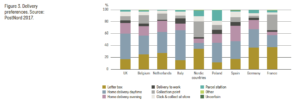For urban planners, retailers and logistics companies, the growing flow of products from manufacturer to consumer presents new challenges. What is the impact of increasing e-commerce in our European cities? And what can be done to facilitate this transformation of our shopping habits?
A new report by Peter Sommar and Peter Mellander ‘Signed, Sealed, Delivered – Analysing the Impact of E-commerce on Urban Areas‘ explores European e-commerce and the development of last mile supply chains.
E-commerce trends
Consumers’ shopping habits differ between European countries, different age groups and areas. Eurostat statistics show that e-commerce is used by urban as well as rural inhabitants although urban inhabitants in many countries use it to a greater extent. Statistics also reveal that younger people are generally more inclined than older people to make online purchases.
The time saving aspect is the most important reason for some consumers. For other consumers, the range of products available offers access to products not available in local stores. Price is important for many consumers, and e-commerce offers competitive prices.
Retail supply chain solutions are experiencing a shift in required performance – and therefore also in the optimal supply chain design – as compared with traditional processes for supplying retail stores. The convenience aspect is expected to place even greater demands on delivery time and convenient options such as home delivery. And, e-commerce growth will further reveal and accentuate the demand for sustainability of last mile solutions.
Impact
Recent research findings suggest that an increase in e-commerce might produce both positive and negative effects for cities. From a citizen perspective, the effects of e-commerce may be experienced as less time spent travelling to and shopping in stores resulting in a decrease in brick-and-mortar shopping, and a change in personal travel patterns. At the same time packaging waste and urban freight traffic in residential areas is likely to increase. E-commerce might also change our homes. Some early adopters even allow in-home delivery when they are not at home. An increase in these types of last mile solutions is expected.
According to the researchers, e-commerce is sometimes far from beneficial for supply chain efficiency, and therefore does not always promote a sustainable society. In meeting these new demands, the retail supply chain is facing a potential paradigm shift. Warehousing operations and locations, and transport solutions are profoundly affected by e-commerce, as single items need to be stored, handled, packaged, and delivered and return flows need to be managed. Packaging and product returns increase energy use and place new demands on the supply chain.
Solutions for last mile deliveries
Last mile logistics is generally considered the most expensive, least efficient and most polluting part of the supply chain. To improve e-commerce competitiveness and efficiency new solutions are developed and tested continually. There are a number of solutions for last mile deliveries. Home delivery, pick-up at a collection point, parcel locker and click-and-collect in-store all have their pros and cons.
The key challenges in urban areas are the resources required, the environmental impact and cost efficiency of last mile transport, and the location and function of distribution facilities. These challenges have an impact throughout the supply chain and in urban planning; from warehouse design and location, delivery networks of hubs, local depots and transportation, to and into consumers’ homes.
Smart packaging solutions that improve fill rates, reduce waste, and enable recycling and re-use are a natural part of efficient logistics. The inefficiency of today’s solutions highlights the need for innovative thinking to identify solutions for efficient distribution principles and supply chain strategies and design, integrated into urban structures. Stakeholders throughout the supply chain will benefit by looking beyond their current boundaries and interests to search for efficient solutions through collaboration, co-ordination, co-location and co-transportation.
Government
Authorities and other stakeholders can promote and support new ideas and new thinking regarding the development of solutions for sustainable supply chain design. Authorities can also inform citizens about the impact of e-commerce. Last mile logistics needs to be given high priority on the regional political agenda, and authorities can guide development through regulations and incentives to steer initiatives in a more sustainable direction.
Source: Sweco – Urban Insights

